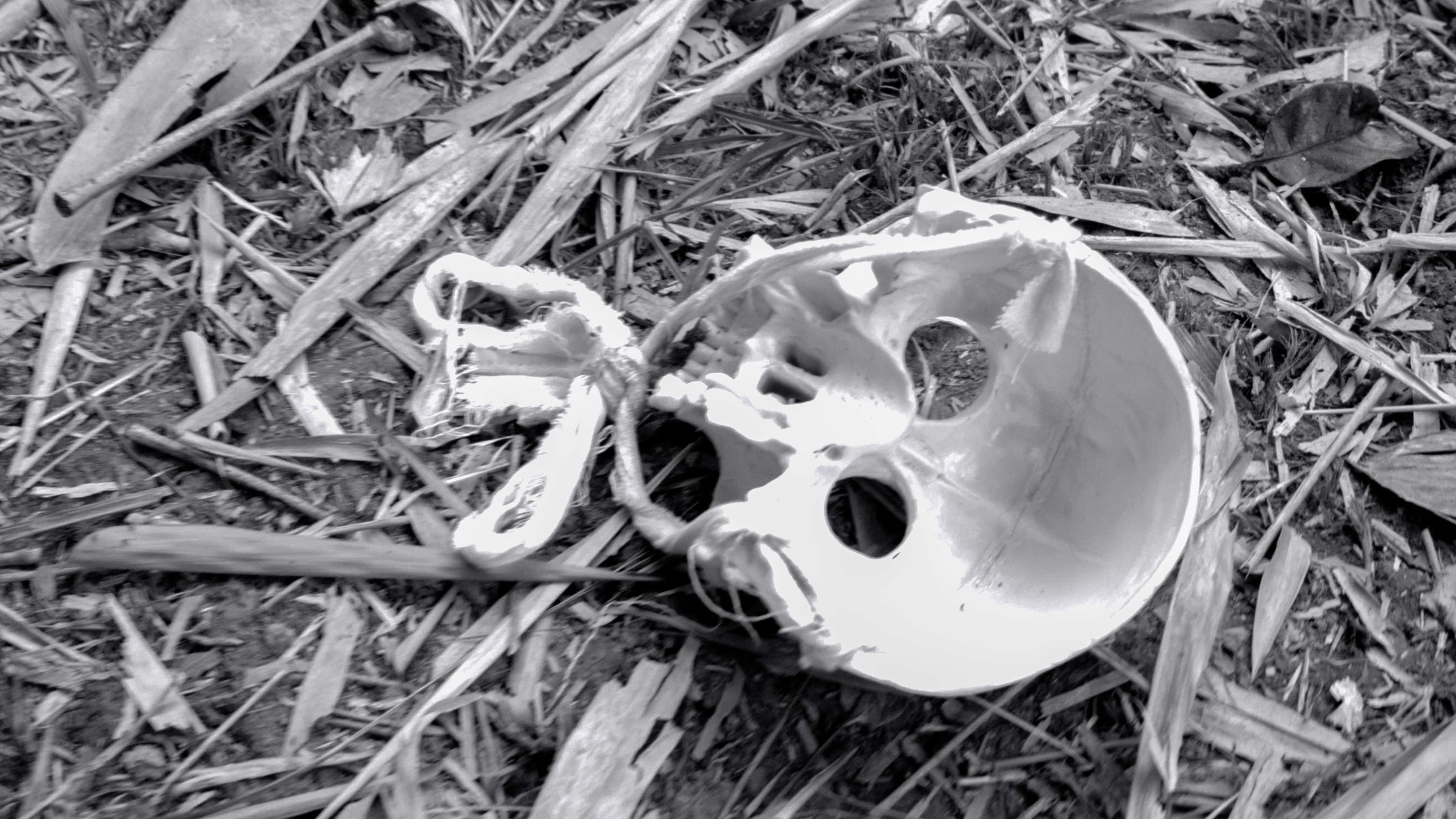「琥珀之夢」沿承了作者近年對私歷史之於國族意識型態變遷的討論,以及採用降靈手法啟動歷史復魅的編導手法。展覽包括一組五頻道錄像裝置《父域安魂曲》,和與個展同名的《琥珀之夢》劇照攝影,分別透過不對稱之薄紗屏幕、以及燈箱形式,再現心智的殘像,並藉動靜影像之間的互相傾注,反映現實、幻夢、與敘事重構之間的拉扯。
宛如一場自我精神分析的「琥珀之夢」,暗示回憶可能比過往更加真實,而夢則收容了記憶與遺忘。在這記憶與遺忘如洋流般熱切摩娑的交會地帶,邪典(Cult)能量噴發,倫常與慾望、愛與死、暴力與純真、存在與失落,快速翻攪、碰撞,它們難得頭暈目眩,暫時彼此原諒。
Inheriting the exploration on the relationship between personal history and the shifting ideology regarding nationality, Lin’s latest project “Dream of Amber” focuses on the state of self being a container of memories and the forgotten. The exhibition includes a multi-channeled video installation: Requiem for the Realm of Father, a series of photo stills, the exhibition demonstrates the dialectical process of struggles between reality, hallucination, and reconstruction.
Through direction and mise–en–scène, the reality and the fictional scenes are intertwined, therefore the context of childhood has been re-captured. By this way, memories and oblivions connect again, which can be seen as the resistance of destiny, and the requiem for the family. The self-psychoanalysis in “Dream of Amber” suggests that the memory is more realistic than the reality, while a dream is the shelter for both memories and the forgotten, which is like the meeting of warm and cold ocean currents, where the so-called “cult” energy sprouts, blurring the banality of ethics and desire, love and death, violence and pureness, and existence and loss. Through this dizziness, they have temporarily forgiven each other.
林羿綺 Lin Yi-chi
1986年出生於台北,創作涉足錄像、實驗電影和新媒體表演領域。
將影像視爲一種降靈媒介,重新編導與建構出超越真實的情境樣態,以此召喚邊緣野史,進行對國族、歷史、與家族記憶的復魅與再生產。另一方面則發展對影像與文本的相關思考,探尋類比與數位影像間的邊界,捕捉動態影像作為一種材質的的斷裂特性,更嘗試將身體介入影像,發展穿越新舊媒體間跨界展演。
曾受邀多個國內外策展專案、影展、以及駐村計劃,更多次榮獲影展與藝術獎項。其特殊的作品氛圍,極具顛覆傳統的實驗精神。
Lin Yi-chi was born in 1986 in Taipei. Lin’s video works, experimental cinema, and performance have focused on transforming the image making process into a necromancy-like ritual that summons the marginal and unofficial memories to facilitate the re-enchantment of national and family history, while recreating the realities that surpass reality at the same time. Furthermore, Lin has been rethinking the relationship between analog and digital images, and exploring to capture the fragmented nature of imagery. In addition, her regular performances in her own works are seen as body involvement that practices the cross-disciplinary embodiment.
Lin has been invited to several international residency programs and her works have been exhibited in many curatorial projects and film festivals, and also been awarded many times for the unique ambiance and subversiveness in her works. Lin’s works are known for the unique ambiance and the subversive experimental spirit.
梁云繻
呂易倫
呂易倫、梁云繻、陳佑先、石欣平、鄭智炫
辛娟綺、林怡君、林晏竹、陳飛豪、黃鈴珺
福利社空間
2017 國家文化藝術基金會第一期美術類補助計劃
林羿綺
林羿綺、辛娟綺
呂易倫
辛娟綺
陳楚儀
蘇意惠
林羿綺
林羿綺
蔡忠諺
林羿綺
宋微暄
何美瑜
福利社
關鍵字
藝術家談作品
「藉由自己的私歷史,我想印證過去的歷史樣貌,並且作為我對過去生長環境的提問。」林羿綺說,「這是為父親所安排的安魂儀式,同時也是為自己安魂。」
一位住在眷村裡的金門男子,在眷村中被視為本省人,出了眷村又被看作是外省人,自我內在認同價值的混亂,加上外在環境的政治氛圍,形塑了他不羈的一生……
《琥珀之夢》為藝術家林羿綺在國立台北藝術大學美術系研究所畢業個展之外的第一次對外獨立個展,她將自身作為回憶與失憶載體的狀態,在五頻道錄像裝置《父域安魂曲》中,採用降靈手法啟動歷史復魅的畫面,透過真實事件與虛構場景的編導與場面調度,童年家庭的時境被重新擷取,記憶與遺忘再次輪迴。而一系列劇照攝影、衣冠塚形式的文件裝置,則對照著現實、幻夢,與重構之間的種種拉扯。
封存在琥珀中的夢與幻覺
「小時候多夢,常分不清腦中那些光怪陸離的畫面是記憶還是幻覺,直到長大後才發現,這些潛藏在意識底層的片段,竟然真真實實的發生過!而它們就如同被封存在琥珀一般,成為幻覺和夢境。」林羿綺說,夢收容了記憶與遺忘,而這場展覽就像是人工琥珀,透過夢境,呈現封存記憶與遺忘的過程。
《琥珀之夢》的核心作品為《父域安魂曲》,這部錄像裝置是以編導的方式,重演林羿綺過去與父親的種種晃蕩經歷。作品以「安魂夜」、「進堂詠」、「奉獻經」、「羔羊贊」、「垂憐經」為章節,分別對應著五種感官,由林羿綺以台語緩緩道出催眠式旁白,開啟這招靈與安魂的儀式。
林羿綺企圖挑戰傳統影像的觀影模式,大量使用切割畫面與影像閃回,企圖去捕捉童年腦内記憶中的影像殘影,從看似獵奇的觀點,回顧真實經歷的生活情境,如80年代大眾媒體傳播的政宣內容、吸毒與電玩店的次文化場景,縱情性愛的畫面,接引出屬於父親的往日年代。而在這記憶與遺忘如洋流般熱切摩娑的交會地帶,倫常與慾望、愛與死、暴力與純真、存在與失落,快速翻攪、碰撞,它們難得頭暈目眩,暫時彼此原諒。
影片中,林羿綺戴上面具,象徵著父親的亡靈,如何以女體表現,對她而言是很大的挑戰。故事最後,林羿綺褪去所有衣物與面具,抽離回憶,也告別亡靈。「是時候要離開了,請原諒我沒辦法把骨與肉還你,因為這是你曾出現在這世界唯一的證據,我只好帶著你一半的肉體,繼續存活在這個世間,做你永世的未亡人。」影片結束前的這段旁白,道出了她與父親的情感牽繫。
由虛轉實的記憶之境
值得一提的是,《琥珀之夢》同時也是策展人梁云繻第一次策劃的個展,她藉由西方藝術史的背景,協助林羿綺處理過往的黑色記憶,共同梳理創作脈絡,挑戰影像裝置語彙的呈現形式。
而在展場規劃上,由於「福利社FreeS Art Space」位於地下室,且有迴廊,因此梁云繻使用薄紗式布幕,讓影像得以穿透進空間之中,並且消除展覽場地的畸零性。這些布幕既是投映的介面,也是區隔空間用的布簾,五段影片有五個空間,觀眾必須穿越它們才能抵達下一個章節,而在觀眾撥動穿梭於不斷搖晃的布幕時,場景看上去更加迷離恍惚,彷彿進入一種如夢似詭的幻境裡,林羿綺的記憶之境,就這麼由「虛」轉「實」了。
梁云繻認為,這場展覽像是一種召喚,許多人看了之後,記憶被一一喚醒,也有更多故事被分享出來。雖然展覽的時間是在炎熱的盛夏,鬼魅般的氣氛卻讓觀眾覺得很「清涼」!但無可否認,《琥珀之夢》的本質在情感上是非常溫暖的。
「藉由自己的私歷史,我想印證過去的歷史樣貌,並且作為我對過去生長環境的提問。」林羿綺說,「這是為父親所安排的安魂儀式,同時也是為自己安魂。」
評審談作品
「琥珀之夢」,成功透過重建父親過往,以多重甚至對立角色降靈,在個人、家族、社會、國家等歷史殘局之間,形成身體性、靈異性極強的流動連結。
入圍理由
台灣的集體悲情,和例如殖民與國家統治、產業經濟型態、家族與世代等的多重歷史殘局有關。林羿綺有奇特家庭背景,祖父為失蹤情報員、功於國而進駐眷村、台灣底蘊造成隔離、集體被迫遷離眷村的經歷、父親因過繼成為家族成員、曾跟後來自殘的父親渡過晃盪甚至反社會生活等。「琥珀之夢」,成功透過重建父親過往,以多重甚至對立角色降靈,在個人、家族、社會、國家等歷史殘局之間,形成身體性、靈異性極強的流動連結。(主筆/黃海鳴)
Comments on the finalist artworks
Taiwan’s collective pathos is related to multiple historical contexts and reasons, including colonial and national regimes, industrial and economic forms, as well as families and generations. LIN Yi-Chi comes from a rather unique family. Her grandfather was a missing intelligent agent. Because of the grandfather’s dedication, the family was able to live in a military dependents’ village. However, their Taiwanese background caused the family to live in an isolated state and they were eventually forced to move out of the village. Lin’s father was adopted into the family, and the artist once lived a wandering and even anti-social life with her father. Through a successful construction of the paternal past, Dream of Amber performs a séance with multiple and sometimes opposing characters. Amidst the unsettled individual, family, social and national histories, the work creates fluid connections informed by a strong degree of corporeality and supernaturality. (Commentator: HUANG Hai-Ming)


.jpg)
.jpg)




